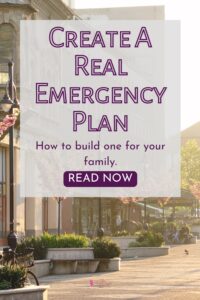
Natural disasters don’t send calendar invites. They show up unannounced, unapologetic, and usually at the worst possible time. When the storm clouds gather or the ground starts to shake, you don’t want to be flipping through a dusty binder of half-baked plans. You need something that actually works—something built around real people, real lives, and real situations. Creating a homegrown real emergency plan isn’t about paranoia; it’s about taking control before chaos gets the chance to.
Download Your FREE Emergency Preparedness Resources HERE
This post contains affiliate links. Read my affiliate link disclosure here
Start with Conversation, Not a Checklist
Before you run to the hardware store or start Googling prepper supplies, gather your people around the table. The most overlooked step in emergency planning is actually talking through what everyone would do if disaster struck in the middle of dinner or while half the household is at school or work. Let each person voice their concerns, ideas, or even their fears—it helps to understand how everyone reacts under pressure. You’re not just forming a plan, you’re building team chemistry, and that part is often missing in the one-size-fits-all advice floating around online.
Map Your Risks Like You Know Your Neighborhood
Every area has its own personality when it comes to natural threats. What rattles California may soak Florida or bury Colorado. Get familiar with the risks in your region, but don’t just rely on statistics—talk to neighbors, check local emergency management sites, and dig into what’s actually happened before. Understanding your local terrain, flood zones, or fire lines
helps you prioritize what matters most when minutes count. A strong plan starts with recognizing what you’re most likely to face and tailoring your moves to match that landscape.
Put It In Writing
It’s one thing to talk through your emergency plan, but it’s another to have it clearly written down where anyone in your household can find and understand it. You’ll want a simple document that lists your evacuation routes, supply inventory, emergency contacts, medical information, and anything else someone might need in a pinch. Save it as a PDF so it stays locked in format and easy to open on just about any device, even without an internet connection. If you ever need to make updates, you can use Adobe Acrobat for PDF editing.
Build A Go-Bag That’s Actually Useful
You’ve probably seen a hundred lists telling you to pack canned food, batteries, and a flashlight. And sure, those are basics—but the best emergency bags aren’t generic. They’re personal. Think about including comfort items for kids, backup chargers, prescriptions, and maybe even copies of important documents on a USB drive. Label the bag clearly, stash it somewhere everyone knows, and check it every six months so it doesn’t turn into a time capsule of expired granola bars and dead batteries.
Download Your FREE Emergency Preparedness Resources HERE
Know Where You’ll Go, Even If You Don’t Want To Leave
Evacuation plans often get discussed in vague terms, but you need more than a general direction. If you had to get out in under five minutes, where would you go? Who could take you in? Which roads would be safest and which ones flood first? Identify at least two escape routes and choose rendezvous points outside of your neighborhood. That way, if cell towers go down and your family scatters, there’s still a plan for coming back together.

Teach the Plan Without Making It Scary
Kids don’t need every detail, but they shouldn’t be left in the dark either—literally or figuratively. Make it interactive by turning parts of the plan into games or drills. Practice “what if” scenarios like a blackout during dinner or a tornado warning during bedtime. The goal isn’t to instill fear but to build confidence so that when things go sideways, even the youngest members know how to respond.
Include Your Pets in the Picture
Too many emergency plans forget the furry family members until the last second. If your pet needs medication, special food, or a crate, you won’t want to be scrambling for those things during an evacuation. Find out which shelters or hotels accept animals, or work out a buddy system with a friend in a neighboring area. Keep a small emergency kit for your pet, just like you do for everyone else—it sends a clear message that no one gets left behind.
Stay Flexible, Because No Plan Survives Reality Unchanged
Even the best-laid emergency plans need wiggle room. Disasters unfold unpredictably, and what seemed like a smart move on paper might not make sense in the moment. That’s why it’s crucial to build flexibility into your plan—alternate routes, secondary meeting spots, and backups for your backups. Regularly review and update your plan as your family, neighborhood, or local threats change. Being too rigid can be just as dangerous as having no plan at all.
In Conclusion…
A real emergency plan isn’t a fire extinguisher that sits behind glass—you can’t afford to forget it until you need it. You should live with it, revisit it, and practice it so that when trouble shows up uninvited, your family isn’t caught flat-footed. This isn’t about checking boxes or stockpiling gear for the apocalypse. It’s about knowing that when the sky darkens or the water rises, your household already knows what to do. Because when everyone else is trying to figure things out, you’ll be moving with purpose.
Discover how to create a personalized food storage plan that fits your family’s unique dietary needs and lifestyle at The Merrill Project.
Thank you to our guest writer Sharon Wagner for another fantastic informational piece.
If you liked this post, please let us know. Leave a comment below and click those share buttons to tell your friends. As always, we appreciate you taking a minute of your time to spread the word about preparedness.
